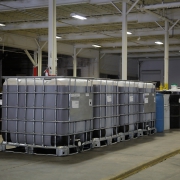6 Steps for Proper Hazardous Waste Disposal
Each year, there are numerous cases of improper hazardous waste disposal that impact human health and the environment, and most, if not all cases, can be prevented if the correct steps are taken to discard waste.
When the appropriate procedures are taken for the disposal of hazardous waste, many benefits arise. These benefits include:
- Improved protection of human health and the environment
- Reduced waste created
- Increased recycling and recovery of materials
- Conservation of energy and natural resources
To ensure you are doing your part in helping to promote these benefits, be sure to follow the steps below on proper hazardous waste disposal.
How to Dispose of Hazardous Waste
1. Identify
The first step of hazardous waste disposal is identifying the type of waste present and completing a waste profile to classify the waste and determine how to safely handle it through disposal.
2. Quantify
The next step of waste disposal is to determine how much waste is present. This is significant because it identifies the generator status which is linked to the amount of waste produced. Generator status falls under three categories:
- Very Small Quantity Generators (VSQGs) generate no more than 100 kilograms (220 pounds) of hazardous waste, or no more than one kilogram of acutely hazardous waste per month.
- Small Quantity Generators (SQGs) generate more than 100 kilograms (220 pounds), but less than 1,000 kilograms (2205 pounds) of hazardous waste per month.
- Large Quantity Generators (LQGs) generate 1,000 kilograms (2205 pounds) or more hazardous waste, or more than one kilogram of acutely hazardous waste per month.
Your designated category determines the additional regulations by which you must abide for hazardous waste disposal.
3. Notify
If the generator status for hazardous waste disposal is classified as LQGs or SQGs, it is required to obtain a federal Environmental Identification Number and report hazardous waste activities using Form 8700-12 to the Environmental Protection Agency (EPA). Some states may also require you to notify one of their agencies if they have their own hazardous waste program. Additionally, some states may even require VSQGs to report their activities.
For more information regarding obtaining an EPA ID Number, conducting proper notification and recordkeeping practices, visit the EPA website.
4. Manage
LQGs, SQGs, and VSQGs all must comply with their specific set of regulations when it comes to hazardous waste disposal. It is important to note that certain types of wastes have unique requirements and certain business sectors may be able to utilize exemptions. In addition to federal regulations, the state your facility is located in may have regulations and requirements that must be followed.
5. Transport
Before the process of hazardous waste disposal, transportation of the waste must be planned. To transport waste, it must be placed in a compatible DOT compliant container and properly labeled.
Proper packaging starts with choosing the correct type of container. You want to ensure that the waste is not going to react with the container itself or increase the chance of failure or release. For example, corrosives should not be put in steel drums that they can corrode. Instead, plastic or plastic-lined drums tend to be the better solution.
Your containers should also be properly marked and labeled. This includes, but is not limited to, the United Nations Performance Oriented Packaging Marking, the hazardous waste marking, and the DOT hazardous materials diamond(s).
Lastly, all hazardous waste must be listed on an appropriately filled out Hazardous Waste Manifest. This includes, but is not limited to, the generator and transporter’s address, proper U.S. DOT descriptions, and respective signatures.
6. Dispose
Once your hazardous waste is properly packaged and labeled, it’s time to determine of how it is going to be discarded. Some wastes such as used oil can be recycled or burned for energy while certain acids and caustics can be treated and stabilized, and many other wastes can be securely discarded in an EPA-permitted landfill. Information on the waste profiles will help the disposal facility determine the correct handling procedures and the treatment method that will be most effective.
How can I get help with my hazardous waste disposal?
For more information on hazardous waste identification, transportation, and disposal, reach out to EnviroServe. Our Team specializes in “where you need us, when you need us” service with 30 years of experience. Contact (800) 488-0910 for all your waste management needs.

